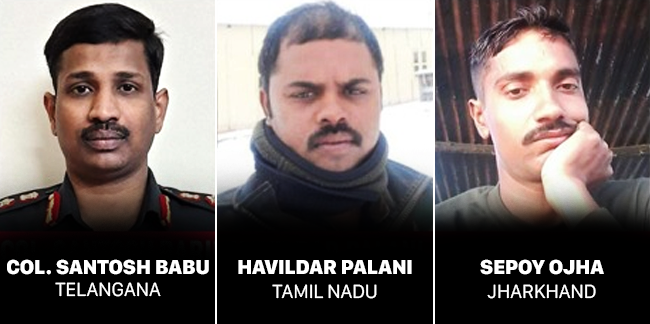Army Colonel among 3 killed in Ladakh face off
 NEW DELHI : Colonel Santosh Babu was among those who lost his life during violent clashes with Chinese troops at the Line of Actual Control (LAC) in the Galwan Valley in the Eastern Ladakh region. Along with him, two jawans were also martyred in the deadly clash.
NEW DELHI : Colonel Santosh Babu was among those who lost his life during violent clashes with Chinese troops at the Line of Actual Control (LAC) in the Galwan Valley in the Eastern Ladakh region. Along with him, two jawans were also martyred in the deadly clash.
Colonel Santosh was the Commanding Officer of the 16 Bihar regiment. He died during the face off with Chinese soldiers in Galwan valley area near Patrolling Point 14. Along with him, two jawans were also martyred in the deadly clash.
Even though an investigation of the precise circumstances under which Colonel Babu was killed is still underway, a senior military official said he appeared to have been targeted by PLA troops in the course of the melee, likely while attempting to defuse the savage fighting.
The Army said India lost an officer and two soldiers during the violent face-off, while there were casualties on the Chinese side as well. The number of casualties on the Chinese side is not yet clear.
“I am both sad and happy,” said Santosh’s mother Manjula, while speaking about her son’s death to the media. Breaking into tears, she added, “I am happy that my son sacrificed his life for the country but as a mother, I grieve his loss. He is my only son.”
Colonel Babu is survived by wife Santhoshi and two children, a nine-year-old daughter and a four-year-old son. While his parents live in Suryapet, his wife and children are in Delhi.
Santhosh Babu was a resident of Vidya Nagar in Suryapet. He graduated from the Indian Army’s prestigious National Defence Academy (NDA) after initial education from Korukonda Sainik School, Hyderabad. His father is a retired Bank manager.
Meanwhile, Defence Minister Rajnath Singh briefed Prime Minister Narendra Modi about last night’s clash as well on the overall situation in eastern Ladakh after he held a high-level meeting with External Affairs Minister S Jaishankar, Chief of Defence Staff Gen Bipin Rawat and the three service chiefs.
According to a senior military officer, it is the first incident involving the casualty of an Indian soldier in a violent clash with the Chinese Army after 1975 when four Indian soldiers were killed in an ambush at Tulung La in Arunachal Pradesh.
The only admission of casualties on the Chinese side so far has come from the editor of their government mouthpiece Global Times. “Based on what I know, Chinese side also suffered casualties in the Galwan Valley physical clash. I want to tell the Indian side, don’t be arrogant and misread China’s restraint as being weak. China doesn’t want to have a clash with India, but we don’t fear it,” tweeted Hu Xijin, Editor-in-Chief of Global Times.
Beijing, in an aggressive statement, accused India of crossing the border, “attacking Chinese personnel”, reported AFP. China’s Foreign Ministry was quoted by Reuters as saying India should not take unilateral actions or stir up trouble.
“What’s shocking is that on June 15, the Indian side severely violated our consensus and twice crossed the border line and provoked and attacked the Chinese forces, causing a violent physical confrontation between the two border forces,” Chinese foreign ministry spokesperson Zhao Lijian told reporters in Beijing. “China is raising strong opposition and stern representations to the Indian side on this,” he said.
For more than six weeks now soldiers from both sides have been engaged in a stand-off at least two locations along the Line of Actual Control the 3,488 km de-facto boundary between India and China, and have rushed additional troops to the border.
After weeks of face-off including an incident in which patrolling soldiers clashed on the banks of Pan gong Lake, resulting in injuries, friction eased following talks. Indian and Chinese military commanders had been in talks in Galwan Valley area and Hot Springs.
China has been upset about the Indian construction of roads and air strips in the area. The government has pushed for improving connectivity and by 2022, 66 key roads along the Chinese border will have been built. One of these roads is near the Galwan valley that connects to Daulat Beg Oldi air base, which was inaugurated last October.
“From what we know so far,” a military officer said, “it doesn’t appear that there was any great planning behind China’s actions. The most likely explanation is that they just didn’t expect us to stand our ground.”
In 1975, the PLA had ambushed an Assam Rifles patrol at the Tulung La pass in Arunachal Pradesh and killed four. Earlier, in 1967, 88 Indian soldiers and perhaps as many as 340 PLA troops — were killed in the course of skirmishes near Nathu La and Cho La, the gateways to the strategically-vital Chumbi valley.
(With Agency Inputs ).

